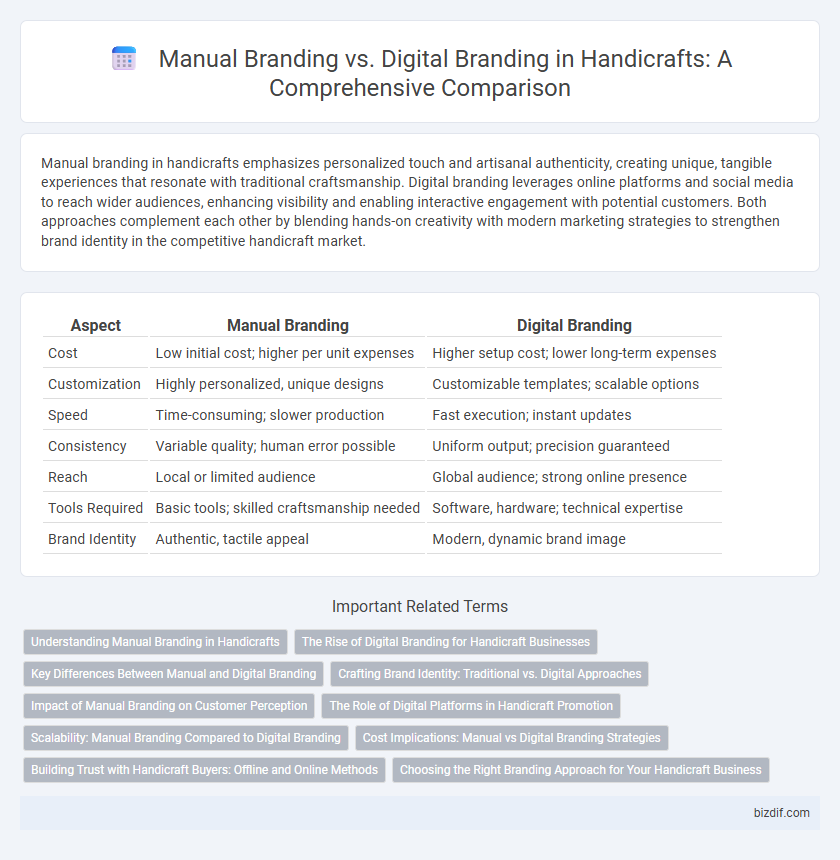Manual branding in handicrafts emphasizes personalized touch and artisanal authenticity, creating unique, tangible experiences that resonate with traditional craftsmanship. Digital branding leverages online platforms and social media to reach wider audiences, enhancing visibility and enabling interactive engagement with potential customers. Both approaches complement each other by blending hands-on creativity with modern marketing strategies to strengthen brand identity in the competitive handicraft market.
Table of Comparison
| Aspect | Manual Branding | Digital Branding |
|---|---|---|
| Cost | Low initial cost; higher per unit expenses | Higher setup cost; lower long-term expenses |
| Customization | Highly personalized, unique designs | Customizable templates; scalable options |
| Speed | Time-consuming; slower production | Fast execution; instant updates |
| Consistency | Variable quality; human error possible | Uniform output; precision guaranteed |
| Reach | Local or limited audience | Global audience; strong online presence |
| Tools Required | Basic tools; skilled craftsmanship needed | Software, hardware; technical expertise |
| Brand Identity | Authentic, tactile appeal | Modern, dynamic brand image |
Understanding Manual Branding in Handicrafts
Manual branding in handicrafts emphasizes authentic, tactile techniques such as hand-stamping, engraving, or embossing directly onto products, preserving traditional craftsmanship and unique artisanal qualities. This approach enhances the perceived value and cultural significance of each piece by showcasing individual skill and manual effort. It contrasts with digital branding by creating a personalized, handcrafted identity that resonates with consumers seeking originality and heritage.
The Rise of Digital Branding for Handicraft Businesses
Digital branding has surged for handicraft businesses due to increased online marketplaces and social media platforms that amplify artisan visibility and customer engagement. Unlike manual branding, digital strategies offer precise targeting, real-time analytics, and scalable content distribution, enhancing brand awareness and sales. Tools such as Instagram, Etsy, and SEO-driven websites enable craftsmen to build authentic digital identities and connect with global audiences effectively.
Key Differences Between Manual and Digital Branding
Manual branding relies on tactile techniques such as hand-painted logos, handcrafted packaging, and physical embossing, offering a personalized and authentic touch to handicraft products. Digital branding utilizes online platforms, social media marketing, and digital design tools to create scalable and versatile brand visibility. The key differences lie in the tangibility and customization of manual branding versus the broad reach and data-driven strategies of digital branding.
Crafting Brand Identity: Traditional vs. Digital Approaches
Manual branding in handicraft involves hands-on techniques such as hand-painting logos, embossing, and custom packaging to create a tactile and authentic brand identity that emphasizes artisanal quality and heritage. Digital branding leverages online platforms, social media, and digital design tools to build a scalable and visually consistent brand presence, targeting broader audiences with interactive content and data-driven strategies. Combining both approaches can enhance brand storytelling by merging tangible craftsmanship with dynamic digital experiences, strengthening customer engagement and authenticity.
Impact of Manual Branding on Customer Perception
Manual branding in handicraft creates a unique, authentic customer experience by emphasizing craftsmanship and tradition, which enhances perceived product value and trustworthiness. The tactile, personalized nature of manual branding fosters emotional connections, making customers more likely to appreciate the story behind each piece. This personalized interaction often leads to increased brand loyalty and positive word-of-mouth, distinguishing handcrafted goods in a competitive market.
The Role of Digital Platforms in Handicraft Promotion
Digital platforms serve as essential tools in handicraft promotion by expanding the reach of artisans beyond local markets to global audiences. These platforms enable targeted marketing, allowing craftsmen to showcase detailed visuals and stories behind their handmade products, thereby increasing customer engagement. Leveraging social media, e-commerce websites, and online marketplaces significantly boosts brand visibility and sales for handicraft businesses.
Scalability: Manual Branding Compared to Digital Branding
Manual branding in handicrafts relies heavily on personalized, labor-intensive techniques that limit scalability due to time and skill constraints. Digital branding leverages online platforms, social media, and automated marketing tools to reach a broader audience rapidly and adjust campaigns in real-time. Scalability in digital branding allows artisans to expand market presence and increase sales without proportional increases in time or material investment.
Cost Implications: Manual vs Digital Branding Strategies
Manual branding in handicrafts involves expenses related to physical materials, labor-intensive processes, and limited scalability, often leading to higher per-unit costs. Digital branding leverages online platforms and automation tools that reduce marketing expenses, increase reach, and provide cost-effective analytics for targeted campaigns. Understanding the cost implications of manual versus digital branding strategies enables artisans to optimize budget allocation while maximizing brand visibility and customer engagement.
Building Trust with Handicraft Buyers: Offline and Online Methods
Manual branding in handicrafts fosters authentic connections through tactile experiences, personal interactions, and showcasing craftsmanship at local markets or workshops, enhancing trust via direct engagement. Digital branding leverages social media platforms, detailed product storytelling, and customer reviews to build credibility and reach a broader audience, ensuring transparency and consistent communication online. Combining offline trust-building methods like face-to-face demonstrations with online strategies such as interactive branding campaigns creates a holistic approach that strengthens buyer confidence in handmade products.
Choosing the Right Branding Approach for Your Handicraft Business
Manual branding in the handicraft business emphasizes tactile authenticity and personal connection, enhancing storytelling and customer loyalty through handcrafted logos or hand-painted designs. Digital branding leverages online platforms, SEO, and social media to reach wider audiences, increase visibility, and engage potential customers with targeted ads and virtual showcases. Selecting the right approach depends on your target market, budget, and desired brand identity, blending manual craftsmanship with digital strategies for optimal growth.
Manual Branding vs Digital Branding Infographic

 bizdif.com
bizdif.com